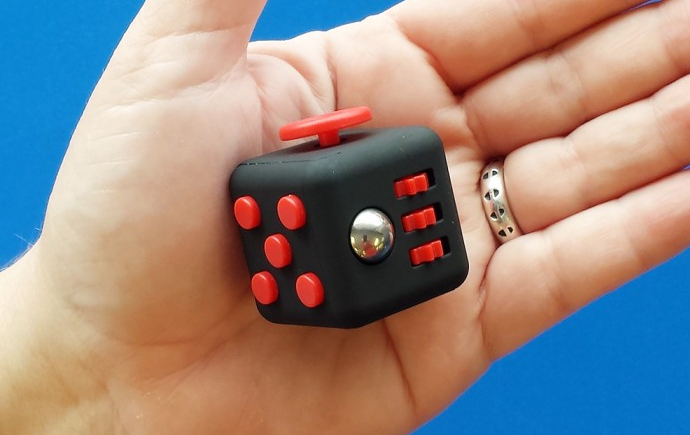An Epidemic of Fidgety Kids? ‘Fidget Widgets’ are the Latest Fad

Two weeks ago, I surprised my daughter by buying her a Fidget Widget, which was on display on a table at my neighbourhood bookstore. It was small enough to fit in her hand, cube-shaped, and had tiny buttons to push down on and a small wheel to spin and various other doohickeys to keep her fingers busy. When I handed it over, it was like I had just announced I had bought her her very own pony. She was thrilled.
My daughter is a fidgeter and, yes, it drives me nuts. Two days later, I was carpooling my daughter and two of her friends to their dance class, and all three teens were fidgeting with their own fidget toys. It is, apparently, a trend.
Why this generation of children so damn fidgety? From playing with slime in class, to squishy toys, children these days seem to need something in their hands to fidget with. The small cubes with various buttons, switches, and clicky things on each side are being sold in droves on eBay and Amazon. There are a few different versions, including not only the Fidget Widget, the Fidget Cube, and the Fidget Spinner—the latter of which is so popular I can’t even get my hands on it. When I called the same local bookstore that I bought the cube-shaped Fidget-Widget from, they said they’re getting the Spinner in very soon, hopefully. ‘I already have a page-long wait list. A ton of people are asking for them.’ the employee told me.
For most parents, watching their kids fidget is annoying at best. How many of us remember our mothers telling us to stop fidgeting? But when I was a child, fidgeting was twirling with my hair or clicking my pen off and on and maybe biting my cuticles. But now, fidgeting is actually…cool? And it’s made fidget toys the latest fad. When I got in touch with the Fidget Widget company and asked the very simple question, ‘Why are our kids so fidgety these days?’ one of the co-founders immediately responded.
‘So many reasons!’ Tomer Nahumi, co-founder of Fidget Widgets, wrote back. ‘I think it’s because children are addicted to devises and computers. There weren’t computers and video game consoles and smartphones when we were children. Now they’re everywhere an children as young as two-years-old are gadget masters.’ He also added, ‘Kids get addicted to playing with these gadgets with their hands. When they can’t use these devices, they need an outlet for their fingers. By fidgeting, it helps them find an outlet for their addicted fingers. They bring a lot of stimulation.’
This rings completely true for me. My daughter doesn’t leave the house, ever, without some sort of hand-held gadget, like the one I bought her. According to Science Focus, ‘fidgeting is a response to anxiety or boredom.’ I think many kids these days suffer from anxiety because kids can no longer just be kids. Whether it’s an unbelievable amount of homework to so many extracurricular activities, I sometimes watch my daughter and think, ‘It’s like a job being a kid these days.’ No wonder there are so many anxious fidgeters.
I did some looking into this, and I learned that ‘anxious fidgeting occurs because the body has elevated levels of stress hormones, which are prepping muscles for sudden exertion. If you don’t have any triggers to run away from at that moment, all that energy has nowhere to go and jiggling your leg or biting your nails partially relieves that.’
According to my daughter and her friends, these fidget toy help them concentrate during tests and while studying. My daughter tells me that the teachers at her school seem fine (so far) with the fidget toys in class and during tests, but not so much with the slime (which is oh-so two months ago!). Fidgeting, however, is nothing new. It may actually be good for you. (Who knew?) Way back in 2005, researchers at the University of Hertfordshire found that fidgeting ‘improved performance in memory tests.’ Why? Fidgeting may ‘[lower] the level of cortisol, a stress hormone that interferes with learning’. Boredom fidgeting, as it is sometimes called, such as drumming your fingers or clicking your pen, may give your brain something to focus on.
Well, there seems to be an epidemic of ‘boredom fidgeting’ students. And it is pissing a lot of teachers off. One teacher wrote in The Guardian, ‘My problem with the fidget cube is not with the beneficial effects it claims to have on its users—though the jury is still out on this matter—but with the effect it has on others in the classroom. When used performatively, students crane their necks to catch a glimpse of it. Yet even when used discreetly under the table, I see students glancing down to look at it, drawn by the various clicking noises. It’s an inescapable distraction. It may be because of its novelty—perhaps over time pupils will become less interested—but for me this is not enough of a reason to continue justifying its presence.’
The problem—sigh—is of course with us parents, who allow (and buy) our kids to take these fidget toys to school. I have no problem with my daughter using one. In fact, many parents I know are now demanding their child use fidget toys during tests, going as far as telling guidance counsellors to allow their child to use them…or else! This, of course, puts teachers in a pickle. As the teacher explains, ‘So far, I have only had to tell students to put the fidget aids in their bags and no more has come of it, bar the occasional grumble of ‘Well, my mum says…’ But what if a student refuses? This would put me, and other teachers, in an awkward position: confiscate the cube and risk meeting angry parents who believe that their child needs it to maximize their learning, or punish those around them for being distracted by it?’ (And, yes, parents are making these demands.)
Apparently these fidget toys were originally created to help people with ADHD or autism to concentrate and focus. But, alas, they have moved into the mainstream (even adults are bringing them into the office) and children are pestering their parents for one. I’m on a wait list for the Fidget Spinner, for my fidgety daughter. Until then, I may suggest her fidgety fingers give me a back or head massage. Just saying.
















I have some apprehension about these things becoming mainstream. They seem to defeat the purpose by turning them into toys that then become disrupting in school because everyone is clicking away on them. Its my understanding they were originally developed to help those who have a real problem like ADHD or Autism. The prices do not reflect the cost to make and replace when they are lost or stolen so its greed fueling the price. I was looking at a metal one that would last but is still over priced at 40 plus shipping. Its brass not gold . I want to get one for my grandson but I resent the over inflated cost. We did find $5.00 versions of the cubes above, knock offs but a fair price because they will get lost. I wonder if everyone in class had one that might reverse the good they do and stress him more. I had never heard of these till recently and they have blown up on the internet like a fad which means it is not going to be less expensive anytime soon.